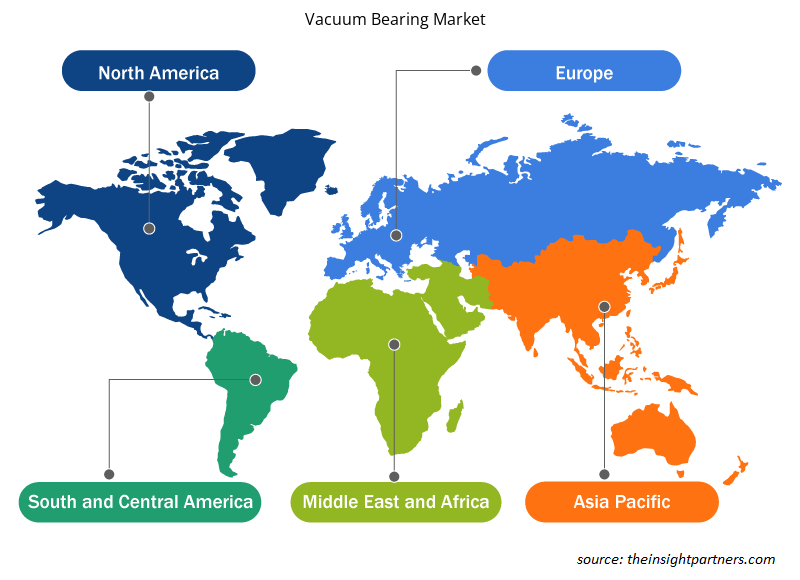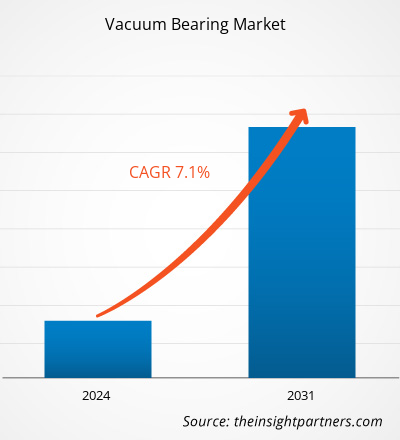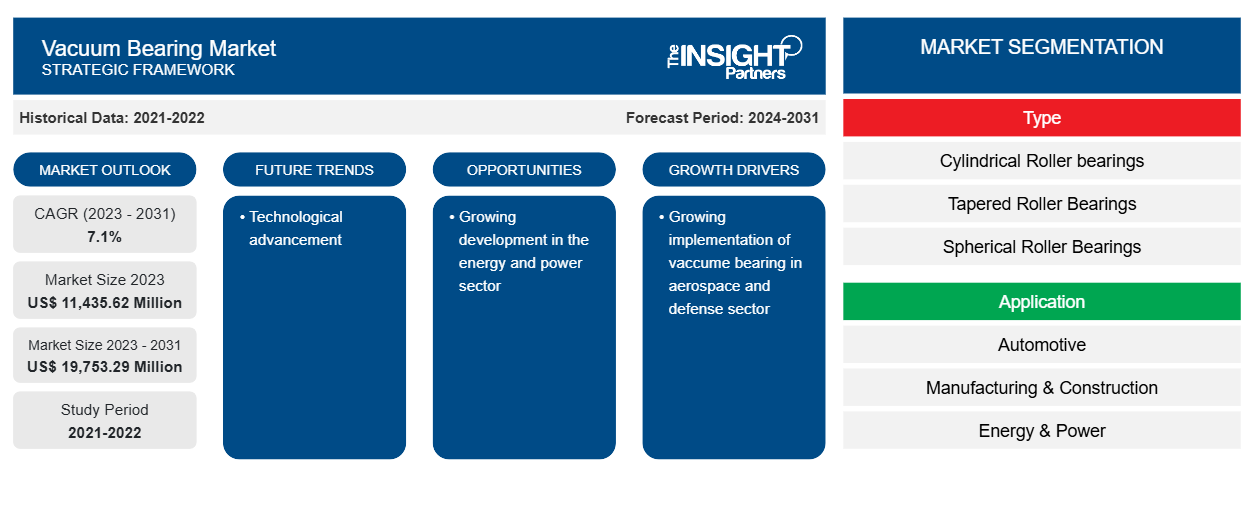Der Markt für Vakuumlager soll von 11.435,62 Millionen US-Dollar im Jahr 2023 auf 19.753,29 Millionen US-Dollar im Jahr 2031 anwachsen. Der Markt wird im Zeitraum 2023–2031 voraussichtlich eine durchschnittliche jährliche Wachstumsrate (CAGR) von 7,1 % verzeichnen. Die wachsende Entwicklung im Energie- und Stromsektor dürfte ein wichtiger Trend auf dem Markt bleiben.
Marktanalyse für Vakuumlager
Zu den wichtigsten Endverbrauchern des Vakuumlagermarktes zählen die Branchen Automobil, Fertigung und Bau, Luft- und Raumfahrt und Verteidigung, Energie und Strom sowie Bergbau. Lager sind eine der wichtigsten Komponenten von Autoteilen. Lager werden zur Unterstützung von Aktivitäten auf mehreren Ebenen eingesetzt, von der Lenkung über die Kraftübertragung bis zu den Rädern. Um mehr über die Verwendung von Lagern in der Automobilindustrie zu erfahren, lesen Sie diesen Blog. Eine der wichtigsten Branchen, in denen viele Lager verwendet werden, ist die Automobilindustrie. Lager werden in der Luft- und Raumfahrt beispielsweise in Flugzeugfahrwerksstreben oder Stoßdämpfern eingesetzt, um Hitzeschäden und Leiterrisse auf der Federbeinoberfläche zu verhindern. Zu den Herstellern von Vakuumlagern gehören HepcoMotion; NSK Ltd; SKF (Kaydon Bearings); UNASIS; Bunting Bearings, LLC; JTEKT Europe Bearings BV. Der Fortschritt in der Lagertechnologie stärkt die Nachfrage nach Vakuumlagern.
Marktübersicht für Vakuumlager
Zu den wichtigsten Stakeholdern im globalen Ökosystem des Vakuumlagermarkts gehören Rohstofflieferanten, Vakuumlagerhersteller und Endverbraucher. Der Rohstofflieferant ist der entscheidende Stakeholder im Ökosystem des Vakuumlagermarkts. Die wichtigsten Rohstoffe sind Silizium, Edelstahl, Hybrid und andere Materialien, die hauptsächlich zur Herstellung der Vakuumlager verwendet werden. Zu den wichtigsten Rohstofflieferanten gehören ASTM International, National Bearings, Kineco Limited, Morgan Advanced Materials usw. ASTM International, ein Rohstofflieferant für Lager, hat sieben neue gesponserte Research to Standards (R2S)-Projekte angekündigt, um das Additive Manufacturing Center of Excellence (AM CoE) von ASTM und sein Ziel zu unterstützen, die AM-Standardisierung und die Brancheneinführung zu beschleunigen. Infolgedessen verbessern verstärkte Aktivitäten der Rohstofflieferanten die Vakuumlagerproduktion und treiben das Marktwachstum voran.
Passen Sie diesen Bericht Ihren Anforderungen an
Sie erhalten kostenlos individuelle Anpassungen an jedem Bericht, einschließlich Teilen dieses Berichts oder einer Analyse auf Länderebene, eines Excel-Datenpakets sowie tolle Angebote und Rabatte für Start-ups und Universitäten.
-
Holen Sie sich die wichtigsten Markttrends aus diesem Bericht.Dieses KOSTENLOSE Beispiel umfasst eine Datenanalyse von Markttrends bis hin zu Schätzungen und Prognosen.
Treiber und Chancen auf dem Vakuumlagermarkt
Zunehmender Einsatz von Vakuumlagern in der Luft- und Raumfahrt sowie im Verteidigungssektor begünstigt den Markt
In der Luft- und Raumfahrt sowie im Verteidigungssektor werden Vakuumlager in allen Flugzeugen eingesetzt, darunter Schmalrumpfflugzeuge, Großraumflugzeuge, Frachtflugzeuge und Jets. Die grundlegende Verwendung eines Vakuumlagers in einem Flugzeug besteht darin, die auf Wellen ausgeübte axiale und radiale Kraft zu verringern. Die Vakuumlager in der Luft- und Raumfahrt ermöglichen auch die einfache Bewegung von Sitzen, Türen und Teilen von Motormanagementsystemen und Flugsteuerungssystemen ohne Störungen. Die wachsende Entwicklung in der Luft- und Raumfahrt sowie im Verteidigungssektor wird voraussichtlich den Einsatz von Vakuumlagern weltweit vorantreiben.
Wachsende Entwicklung im Energie- und Stromsektor
Nahezu alle Formen der Stromerzeugung, wie Kohle, Solar, Wasserkraft, Kernenergie oder Gas, hängen in erster Linie von einem rotierenden Turbinendynamo ab, um das mechanische Potenzial von Wind, Dampf oder Wasser in nutzbare elektrische Energie umzuwandeln . Daher haben die luftgelagerten Produkte zahlreiche und wichtige Anwendungen in der Stromerzeugungstechnologie, da sie die Effizienz senken und kostspielige Ausfallzeiten für bereits verwendete und sich derzeit in der Entwicklung befindliche Technologien vermeiden. Der wachsende Energiebedarf führt dazu, dass die Regierung mehr in den Energie- und Stromsektor investiert, um den steigenden Bedarf zu decken, was gleichzeitig das Wachstum des Vakuumlagermarktes vorantreibt.
Segmentierungsanalyse des Vakuumlager-Marktberichts
Wichtige Segmente, die zur Ableitung der Marktanalyse für Vakuumlager beigetragen haben, sind Typ, Anwendung und Material.
- Basierend auf dem Typ ist der Markt für Vakuumlager in Zylinderrollenlager, Kegelrollenlager, Pendelrollenlager, Axialrollenlager und Nadellager unterteilt. Das Segment der Zylinderrollenlager hatte im Jahr 2023 einen größeren Marktanteil.
- Basierend auf der Anwendung ist der Markt für Vakuumlager in die Bereiche Automobil, Fertigung und Bau, Energie und Strom, Bergbau, Luft- und Raumfahrt und Verteidigung und andere unterteilt. Das Segment Energie und Strom hatte im Jahr 2023 einen größeren Marktanteil.
- Basierend auf dem Material ist der Markt für Vakuumlager in Silizium, Edelstahl, Hybrid und andere unterteilt. Das Edelstahlsegment hatte im Jahr 2023 einen größeren Marktanteil.
Analyse der Marktanteile von Vakuumlagern nach geografischer Lage
Der geografische Umfang des Marktberichts für Vakuumlager ist hauptsächlich in fünf Regionen unterteilt: Nordamerika, Asien-Pazifik, Europa, Naher Osten und Afrika sowie Süd- und Mittelamerika.
Der asiatisch-pazifische Raum ist Marktführer. Regierungsbemühungen im asiatisch-pazifischen Raum, wie etwa die Initiativen „Make in India“ und „Make in China“, um den Fertigungssektor des Landes zu stärken, würden auch der Vakuumlagerindustrie zugutekommen. Die wachsende Entwicklung im Fertigungs-, Bergbau- und Luftfahrtsektor treibt die Nachfrage nach Vakuumlagern im asiatisch-pazifischen Raum an.
Regionale Einblicke in den Vakuumlagermarkt
Die regionalen Trends und Faktoren, die den Vakuumlagermarkt während des Prognosezeitraums beeinflussen, wurden von den Analysten von Insight Partners ausführlich erläutert. In diesem Abschnitt werden auch die Marktsegmente und die Geografie des Vakuumlagermarkts in Nordamerika, Europa, im asiatisch-pazifischen Raum, im Nahen Osten und Afrika sowie in Süd- und Mittelamerika erörtert.

- Holen Sie sich die regionalspezifischen Daten für den Vakuumlagermarkt
Umfang des Marktberichts zu Vakuumlagern
| Berichtsattribut | Details |
|---|---|
| Marktgröße im Jahr 2023 | 11.435,62 Millionen US-Dollar |
| Marktgröße bis 2031 | 19.753,29 Millionen US-Dollar |
| Globale CAGR (2023 - 2031) | 7,1 % |
| Historische Daten | 2021-2022 |
| Prognosezeitraum | 2024–2031 |
| Abgedeckte Segmente |
Nach Typ
|
| Abgedeckte Regionen und Länder |
Nordamerika
|
| Marktführer und wichtige Unternehmensprofile |
|
Marktteilnehmerdichte: Der Einfluss auf die Geschäftsdynamik
Der Markt für Vakuumlager wächst rasant, angetrieben durch die steigende Nachfrage der Endnutzer aufgrund von Faktoren wie sich entwickelnden Verbraucherpräferenzen, technologischen Fortschritten und einem größeren Bewusstsein für die Vorteile des Produkts. Mit steigender Nachfrage erweitern Unternehmen ihr Angebot, entwickeln Innovationen, um die Bedürfnisse der Verbraucher zu erfüllen, und nutzen neue Trends, was das Marktwachstum weiter ankurbelt.
Die Marktteilnehmerdichte bezieht sich auf die Verteilung der Firmen oder Unternehmen, die in einem bestimmten Markt oder einer bestimmten Branche tätig sind. Sie gibt an, wie viele Wettbewerber (Marktteilnehmer) in einem bestimmten Marktraum im Verhältnis zu seiner Größe oder seinem gesamten Marktwert präsent sind.
Die wichtigsten auf dem Vakuumlagermarkt tätigen Unternehmen sind:
- HepcoMotion
- NSK GmbH.
- Schaeffler Technologies AG & Co. KG
- DAS UNTERNEHMEN TIMKEN
- Bunting Bearings, LLC
- TPA Motion, LLC
Haftungsausschluss : Die oben aufgeführten Unternehmen sind nicht in einer bestimmten Reihenfolge aufgeführt.

- Überblick über die wichtigsten Akteure auf dem Markt für Vakuumlager
Neuigkeiten und aktuelle Entwicklungen zum Vakuumlagermarkt
Der Markt für Vakuumlager wird durch die Erhebung qualitativer und quantitativer Daten nach Primär- und Sekundärforschung bewertet, die wichtige Unternehmensveröffentlichungen, Verbandsdaten und Datenbanken umfasst. Nachfolgend sind einige der Entwicklungen auf dem Markt für Vakuumlager aufgeführt:
- HepcoMotion hat in den Niederlanden eine neue Lagerfabrik eröffnet. Dieses neue Werk ist ein bedeutendes neues Unterfangen für HepcoMotion und soll den Produktvertrieb an EU-Kunden beschleunigen und vereinfachen. (Quelle: HepcoMotion, Pressemitteilung, Januar 2022)
- Die Schaeffler Technologies AG & Co. KG hat ihre 12-jährige Partnerschaft mit Rolls-Royce bekannt gegeben. Mit neuesten Produktionstechnologien und Fertigungsmethoden soll Schaeffler Rolls-Royce langfristig unterstützen. (Quelle: Schaeffler Technologies AG & Co. KG, Pressemitteilung, April 2022)
Marktbericht zu Vakuumlagern – Umfang und Ergebnisse
Der Bericht „Marktgröße und Prognose für Vakuumlager (2021–2031)“ bietet eine detaillierte Analyse des Marktes, die die folgenden Bereiche abdeckt:
- Marktgröße und Prognose für Vakuumlager auf globaler, regionaler und Länderebene für alle wichtigen Marktsegmente, die im Rahmen des Berichts abgedeckt sind
- Markttrends und Marktdynamiken für Vakuumlager wie Treiber, Einschränkungen und wichtige Chancen
- Detaillierte PEST- und SWOT-Analyse
- Marktanalyse für Vakuumlager mit Blick auf wichtige Markttrends, globale und regionale Rahmenbedingungen, wichtige Akteure, Vorschriften und aktuelle Marktentwicklungen
- Branchenlandschaft und Wettbewerbsanalyse, einschließlich Marktkonzentration, Heatmap-Analyse, prominenten Akteuren und aktuellen Entwicklungen auf dem Markt für Vakuumlager
- Detaillierte Firmenprofile
- Historische Analyse (2 Jahre), Basisjahr, Prognose (7 Jahre) mit CAGR
- PEST- und SWOT-Analyse
- Marktgröße Wert/Volumen – Global, Regional, Land
- Branchen- und Wettbewerbslandschaft
- Excel-Datensatz
Aktuelle Berichte
Erfahrungsberichte
Grund zum Kauf
- Fundierte Entscheidungsfindung
- Marktdynamik verstehen
- Wettbewerbsanalyse
- Kundeneinblicke
- Marktprognosen
- Risikominimierung
- Strategische Planung
- Investitionsbegründung
- Identifizierung neuer Märkte
- Verbesserung von Marketingstrategien
- Steigerung der Betriebseffizienz
- Anpassung an regulatorische Trends























 Kostenlose Probe anfordern für - Markt für Vakuumlager
Kostenlose Probe anfordern für - Markt für Vakuumlager